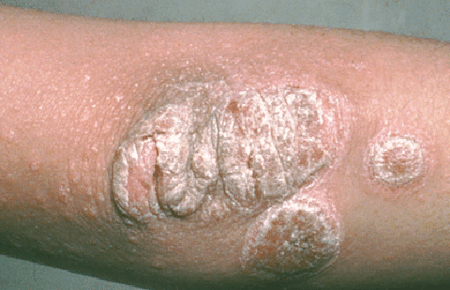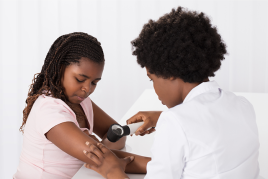Psoriasis: Overview
Psoriasis (suh-rye-ah-sis) is a condition that causes the body to make new skin cells in days rather than weeks. As these cells pile up on the surface of the skin, you may see thick, scaly patches.
Plaque psoriasis is the most common type of psoriasis
Those thick, scaly patches that develop on the skin are called plaques (placks). About 80% to 90% of people living with psoriasis get plaques, so they have plaque (plack) psoriasis1.
Plaque psoriasis on an elbow
When someone has plaque psoriasis, you’ll often see raised patches coated with a silvery-white scale.

Plaques can appear anywhere on the skin, but you’re most likely to find them on the:
Knees
Elbows
Lower back
Scalp
Plaques tend to vary in size. They may appear on the skin as a single patch or join together to cover a large area of skin. No matter the size, plaques tend to be itchy. Without treatment, the itch can become intense. Some people notice that their skin stings, burns, or feels painful and tight.
Psoriasis is often a life-long disease
Most people who get psoriasis have it for life. That’s true no matter what type of psoriasis you have, with one exception. Some children who have guttate (gut-tate) psoriasis see their psoriasis go away. Because psoriasis tends to be a life-long disease, it helps to learn about it and see a board-certified dermatologist. A bit of knowledge and help from a board-certified dermatologist can give you some control over the psoriasis. By gaining control, you can see clearer (or clear) skin. Gaining control can also help you to feel better, improve your overall health, and prevent the psoriasis from worsening.
Gaining control often involves:
Learning (and avoiding) what triggers your psoriasis
Sticking to a good psoriasis skin care routine
Living a healthy lifestyle
Using medication when necessary
Seeing a board-certified dermatologist has another benefit. Psoriasis can increase your risk of developing certain diseases, such as psoriatic arthritis or diabetes. Your dermatologist can watch for early signs of disease. If you do develop another disease, early treatment helps to prevent the disease from worsening. When you see a board-certified dermatologist about psoriasis, your dermatologist may talk about the type(s) of psoriasis you have. It’s possible to have more than one type. You can learn about the different types and see pictures of what each type looks like by going to: Psoriasis: Signs and symptoms
Related AAD resources
1 Menter A, Gottlieb A, et al. “Guidelines of care for the management of psoriasis and psoriatic arthritis, Section 1: Overview of psoriasis and guidelines of care for the treatment of psoriasis with biologics.” J Am Acad Dermatol. 2008; 58:826-50.
Images
Image of plaque psoriasis: Used with permission of the American Academy of Dermatology National Library of Dermatologic Teaching Slides.
References
Bergstrom KG and Kimball AB. “100 questions and answers about psoriasis.” Sudbury, MA: Jones and Bartlett Publishers; 2005.
Habif TP, Campbell JL, Jr., et al. In: Dermatology DDxDeck. 2006. China. Mosby Elsevier. Card #37: “Psoriasis: Lesions.”
Menter A, Gottlieb A, et al. “Guidelines of care for the management of psoriasis and psoriatic arthritis, Section 1: Overview of psoriasis and guidelines of care for the treatment of psoriasis with biologics.” J Am Acad Dermatol. 2008; 58:826-50.
Medical reviewers
Meet the board-certified dermatologists who reviewed this content. Each has conducted research that gives us a better understanding of psoriasis.
 Molluscum contagiosum: How to safely treat it
Molluscum contagiosum: How to safely treat it
 Biosimilars: 14 FAQs
Biosimilars: 14 FAQs
 Practice Safe Sun
Practice Safe Sun
 Relieve uncontrollably itchy skin
Relieve uncontrollably itchy skin
 Fade dark spots
Fade dark spots
 Untreatable razor bumps or acne?
Untreatable razor bumps or acne?
 Laser hair removal
Laser hair removal
 Scar treatment
Scar treatment
 Botox
Botox
 Free materials to help raise skin cancer awareness
Free materials to help raise skin cancer awareness
 Dermatologist-approved lesson plans, activities you can use
Dermatologist-approved lesson plans, activities you can use
 Find a Dermatologist
Find a Dermatologist
 What is a dermatologist?
What is a dermatologist?